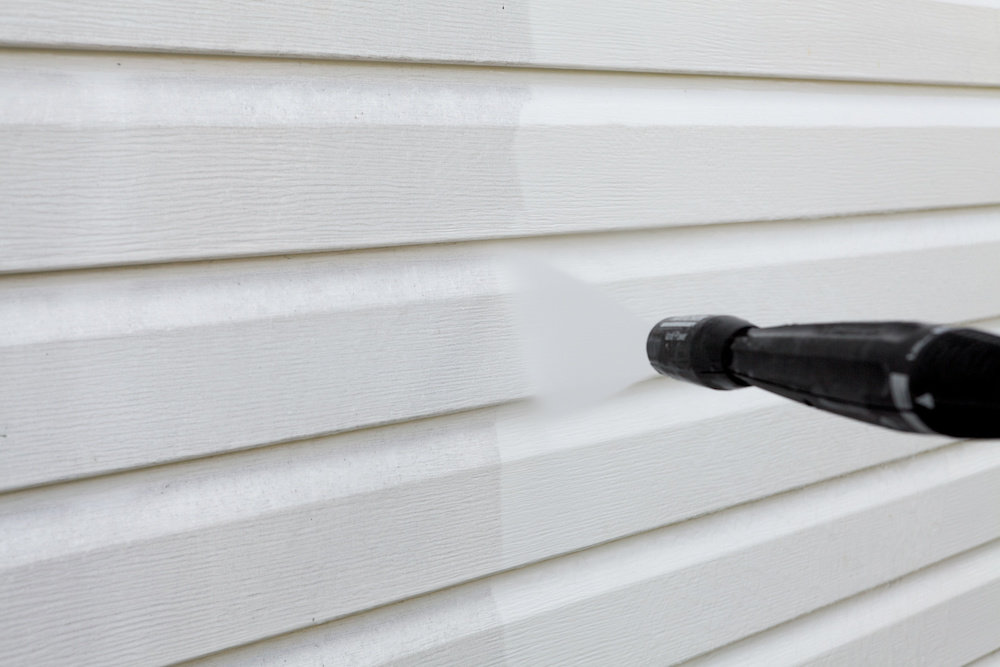Vinyl has become the most popular type of siding due to its low cost and high durability. It is relatively easy to manufacture and comes in many sizes, colors, and textures. Because vinyl will typically last 20 years or longer, it must be cleaned regularly to prevent damage discoloration. Vinyl is susceptible to dirt, grime, green algae, insect remains, mold, mildew, and many other harmful contaminants.
In shady, moist areas, mold and mildew can grow, and vinyl is also vulnerable to discoloring effects from insecticides, herbicides, and fertilizers. In addition, vinyl siding’s finish may be marred by a number of commonly used household maintenance products, including caulking, driveway sealant, tar, motor oil and paint.
Luckily, cleaning vinyl siding is a fairly easy job, and there are a wide variety of products to help remove typical stains. Read on, and we’ll show you how to clean vinyl siding the right way.
Vinyl Siding Cleaner Solutions
70% water, 30% white vinegar makes a great all-purpose vinyl siding cleaner that removes light mold and mildew stains. For a stronger solution, mix together one-third cup powdered laundry detergent, two-thirds cup powdered household cleaner, one quart liquid laundry bleach and one gallon of water. If you are concerned about landscaping, use a vinyl siding cleaner solution composed of one gallon of water mixed with one cup oxygen bleach in a bucket. The oxygen bleach will clean the vinyl without damaging your landscaping. Simple Green offers an environmentally friendly cleanser that is specially formulated for use on vinyl and aluminum siding, stucco, terracotta roof tiles and painted wood. The non-toxic biodegradable concentrate can be used manually or with pressure washers.
Using A Pressure Washer
While cleaning vinyl siding with a pressure washer is much easier than scrubbing your entire home by hand, the risk of damage rises significantly. You should never use a high pressure or focused spray pattern when cleaning vinyl siding.
Using a low-pressure setting, you want to stand eight to ten feet away from the siding of the home. Avoid spraying upwards, as that can push water underneath the siding and dampen the underlying wood. Start by applying a cleaning solution that acts as a general-purpose cleaner and treats the home for algae, mold, and mildew. Some areas may require additional attention. Be sure to lightly scrub those areas with a soft bristle brush. Lastly, rinse the siding with fresh water.
Not Using A Pressure Washer
For the inexperienced, scrubbing vinyl by hand is a safe way to maintain it while preventing damage. Always use a soft-bristle brush preferably with a long handle for those hard-to-reach areas. Using a hard bristle brush will not only scratch the vinyl surface, but also smooth out any texture on the panels.
For light stains caused mostly by mold or mildew, mix 70% vinegar and 30% water. For tougher stains, there are many commercially available products. Be wary of cleaners with organic solvents or undiluted bleach. Lightly scrub the siding starting from the bottom of the home and working your way up to prevent streaking. Be sure to rinse away dirt and grime as it comes loose. Keep in mind, while scrubbing your siding is safe and can improve its look, it’s not nearly as reliable or thorough as using a pressure washer.
Power washing vinyl can be risky. If you are inexperienced or have any doubts, your best bet is to hire a professional. K&T Window Cleaning will eliminate the risk of damaging your vinyl siding and save you the hassle of doing it yourself.
